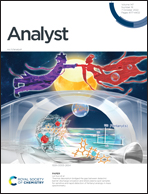A poly(arylene ethynylene)-based microfluidic fluorescence sensor array for discrimination of polycyclic aromatic hydrocarbons†
Abstract
Polycyclic aromatic hydrocarbons (PAHs) are persistent contaminants in the environment. Several of them have carcinogenic properties. There is considerable interest in their sensitive low-cost detection and monitoring. We present a simple paper-based microfluidic sensor for the rapid detection of PAHs. Craft punch patterning generated multiple detection zones inhabited by fluorescent poly(arylene ethynylene)s (PAEs). Changes in fluorescence image and/or intensity of the sensor array were recorded using a smartphone camera. The RGB color values of the photographed images were extracted through ImageJ software. 10 different PAHs were correctly identified using Principal Component Analysis and discrimination analysis (PCA–DA). 100% classification accuracy was achieved for model training, whereas validating the PCA–DA model by cross-validation resulted in 93% classification accuracy for 5.0 mg L−1 analyte.



 Please wait while we load your content...
Please wait while we load your content...